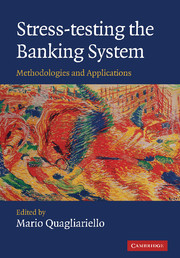Book contents
- Frontmatter
- Contents
- List of figures
- List of tables
- List of boxes
- List of contributors
- Foreword
- Acknowledgements
- Introduction
- Part I Fundamentals
- 1 A framework for assessing financial stability
- 2 Macroeconomic stress-testing: definitions and main components
- 3 Macroeconomic stress-testing banks: a survey of methodologies
- 4 Scenario design and calibration
- 5 Risk aggregation and economic capital
- 6 Data needs for stress-testing
- 7 Use of macro stress tests in policy-making
- Part II Applications
- Conclusions
- Index
- References
7 - Use of macro stress tests in policy-making
from Part I - Fundamentals
Published online by Cambridge University Press: 18 December 2009
- Frontmatter
- Contents
- List of figures
- List of tables
- List of boxes
- List of contributors
- Foreword
- Acknowledgements
- Introduction
- Part I Fundamentals
- 1 A framework for assessing financial stability
- 2 Macroeconomic stress-testing: definitions and main components
- 3 Macroeconomic stress-testing banks: a survey of methodologies
- 4 Scenario design and calibration
- 5 Risk aggregation and economic capital
- 6 Data needs for stress-testing
- 7 Use of macro stress tests in policy-making
- Part II Applications
- Conclusions
- Index
- References
Summary
Introduction
Over the past decade, authorities have increasingly employed stress tests for policy-making, and the use of stress tests for policy decisions continues to be explored and extended. There are two broad approaches to using stress tests by policy-makers: on the one hand, encouragement of individual institutions to use stress tests, and, on the other, the study and application of macro stress-test models by authorities themselves.
Before turning to the main focus of this book, i.e., macro stress tests, we briefly review the use of stress tests by individual institutions. Authorities have increasingly recommended the use of stress tests by financial firms and have embedded stress tests in prudential regulation for banks. For many countries, this is enshrined in the so-called Basel 2 framework, a compilation of guidance on regulatory practices that banking supervisory authorities of major countries have committed to adopt (Basel Committee on Banking Supervision (BCBS), 2006 and 2009). Basel 2 has been recently finalised and is expected to replace the earlier and simpler regulatory framework known as Basel 1. An aspect in the shift from Basel 1 to Basel 2 that is relevant to the use of stress-testing was the acknowledgement of the need to respond to the increasing complexity of banks' activities and, especially for the most advanced banks, the sophistication of their internal risk management. In this light, the recommendation to firms to use stress tests was introduced in Basel 2.
- Type
- Chapter
- Information
- Stress-testing the Banking SystemMethodologies and Applications, pp. 117 - 130Publisher: Cambridge University PressPrint publication year: 2009



